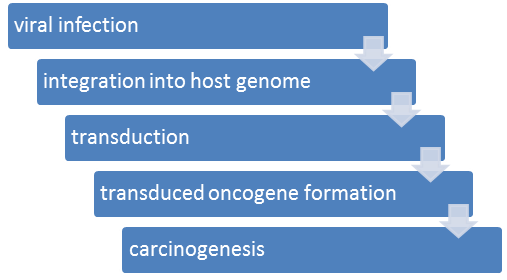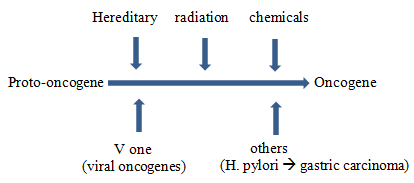Radiations, microbes and chemicals cause mutations, leading to formation of malignant cells. There are three steps in transformation of normal cell into malignant cell:
- Initiation
- Mutations
- Promoters
1. Initiation
Certain chemicals act as initiators.
Definition
Exposure of cells to sufficient dose of carcinogenic agent. (as may also be used as medicinal purpose).
Initiators
Initiators include the polycyclic aromatic hydrocarbons. They are required for DNA damage.
Molecular targets of initiators
DNA is the primary target.
Initiated cells
Undergo proliferation and damage is fixed.
Initiation alone:
Group 1:_x_____________________________ no tumors
Group 2:_x_| | | | | |________________________ tumor
x = application of initiator (polycyclic hydrocarbon)
| = application of promoter (croton oil)
Initiators alone are not sufficient, promoters are required for tumor formation.
2. Mutations
- Permanent DNA damage
- Rapid and irreversible
Group 3: _x___________________| | | | | | | |_____ tumor
Thus promoters are not required soon after initiation, they may develop anytime during life if initiation is present.
3. Promoters
Promoters are the chemicals which cannot cause DNA damage but act on cells after application of initiators. These are:
- Non tumorigenic themselves
- Enhance proliferation of initiated cells
- Do not affect DNA
- Time between multiple applications of promoter is very important and significant
Group 4:__| | | | | | | | | | __x____________________ no tumor
Group 5:__| | | | | | | | | | _______________________ no tumor
Group 6:__x__|__|__|___|____|___|_____________ no tumor
Gap between promoters has to be regular interval, if more than this, no tumor formation occurs.
Promoters should be applied after initiation.
Oncogenic Viruses
Production of certain types of proteins to inactivate certain genes like p53, RB gene.
Tumor viruses are of two distinct types:
1. DNA virus with DNA genome
- Papilloma
- Adenovirus
2. RNA genome termed retrovirus
- Human T cell leukemia virus (HTLVS)
- Human immunodeficiency virus (HIV)
How cells are transformed?
1. Alteration in cell cycle control by viral genes.
They replace normal genes and take over cell cycle.
2. Change in properties of host cell.
Integration –Transduction Pathway by Retrovirus
Protein protein Interaction
- Seen in DNA viruses.
- Virus proteins are termed tumor antigens, they can interact with cellular proteins.
- Inactivate normal function of gene.
- Predominant types of proteins are sequestered by viral T antigens, are tumor suppressor type.
- It is loss of their normal suppressor functions that result in cellular transformation.
1. Human papilloma virus
- Cervical neoplasia –warts, papilloma, cervical cancer.
2. Epstein Barr virus
- Burkitts lymphoma (malignant tumor of lymphoid system common in children)
- Nasopharyngeal carcinoma
3. Human T cell leukemia virus type 1
- Adult T cell leukemia.
- Lymphoma
4. Kaposi Sarcoma virus
- Kaposi sarcoma (malignant tumor of blood vessels)
5. Hepatitis B and C virus
- Hepatocellular carcinoma (malignant tumor of liver)
Radiation Carcinogenesis
Ultraviolet Rays
Ultraviolet rays are derived from sun. These are of three types:
- UV A
- UV B
- UV C
UV B is responsible for cutaneous cancer.
Ultraviolet rays cause induction of mutations, inhibition of enzymes, unrepairable DNA damage (target is DNA)
- Malignant melanoma
- Basal cell carcinoma
- Squamous cell carcinoma
Ionizing Radiations
- X ray workers –leukemia
- Radio-isotopes –thyroid carcinoma (to detect cold and hot nodules)
- Malignancy – very active
- Atomic explosion –skin cancer, leukemia
Radiation Carcinogenesis
Ionizing radiation –> dysjunction –> random fusion –> cancer
Summary of molecular basis of Neoplasia
 howMed Know Yourself
howMed Know Yourself






